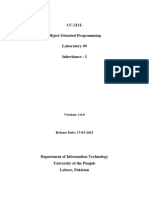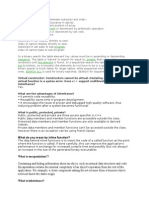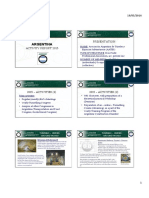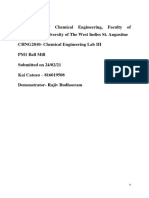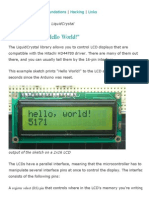Lab 10
Lab 10
Uploaded by
nomanbsitCopyright:
Available Formats
Lab 10
Lab 10
Uploaded by
nomanbsitOriginal Title
Copyright
Available Formats
Share this document
Did you find this document useful?
Is this content inappropriate?
Copyright:
Available Formats
Lab 10
Lab 10
Uploaded by
nomanbsitCopyright:
Available Formats
CC-211L
Object Oriented Programming
Laboratory 10
Inheritance - II
Version: 1.0.0
Release Date: 23-03-2023
Department of Information Technology
University of the Punjab
Lahore, Pakistan
CC-211L Object Oriented Programming FALL 2023
Contents:
Learning Objectives
Required Resources
General Instructions
Background and Overview
o Inheritance
o Base Class
o Derived Class
o Constructor
o Destructor
Activities
o Pre-Lab Activity
Constructor and Destructor in Derived Classes
– Single Inheritance
– Single Inheritance with Arguments
– Multiple Inheritance
– Multiple Inheritance with Arguments
Task 01
o In-Lab Activity
public, protected, and private Inheritance
– Public Inheritance
– Protected Inheritance
– Private Inheritance
Relationship among objects in an Inheritance Hierarchy
– Invoking Base-Class Functions from Derived-Class Objects
– Derived-Class Member-Function Calls via Base-Class Pointers
Task 01
Task 02
Task 03
o Post-Lab Activity
Task 01
Submissions
Evaluations Metric
References and Additional Material
Lab Time and Activity Simulation Log
Laboratory 10 – Inheritance - II Page 2 of 19
CC-211L Object Oriented Programming FALL 2023
Learning Objectives:
Constructors in Derived Classes
Destructors in Derived Classes
Public protected and private Inheritance
Relationship among objects in Inheritance
Resources Required:
Desktop Computer or Laptop
Microsoft ® Visual Studio 2022
General Instructions:
In this Lab, you are NOT allowed to discuss your solution with your colleagues, even not
allowed to ask how is s/he doing, this may result in negative marking. You can ONLY discuss
with your Teaching Assistants (TAs) or Lab Instructor.
Your TAs will be available in the Lab for your help. Alternatively, you can send your queries
via email to one of the followings.
Teachers:
Course Instructor Prof. Dr. Syed Waqar ul Qounain swjaffry@pucit.edu.pk
Lab Instructor Azka Saddiqa azka.saddiqa@pucit.edu.pk
Saad Rahman bsef19m021@pucit.edu.pk
Teacher Assistants
Zain Ali Shan bcsf19a022@pucit.edu.pk
Laboratory 10 – Inheritance - II Page 3 of 19
CC-211L Object Oriented Programming FALL 2023
Background and Overview:
Inheritance :
Inheritance is one of the core concepts of object-oriented programming (OOP) languages. It is a
mechanism where you can derive a class from another class for a hierarchy of classes that share a set of
attributes and methods.
Base Class:
A base class is an existing class from which the other classes are determined, and properties are
inherited. It is also known as a superclass or parent class. In general, the class which acquires the base
class can hold all its members and some further data as well.
Derived Class:
A derived class is a class that is constructed from a base class or an existing class. It tends to acquire all
the methods and properties of a base class. It is also known as a subclass or child class.
Constructor:
A constructor in C++ is a special method that is automatically called when an object of a class is created.
Destructor:
A destructor is a member function that is invoked automatically when the object goes out of scope or is
explicitly destroyed by a call to delete.
Laboratory 10 – Inheritance - II Page 4 of 19
CC-211L Object Oriented Programming FALL 2023
Activities:
Pre-Lab Activities:
Constructor and Destructor in Derived Class:
Single Inheritance:
When an object of the derived class is created, a part of the base class is also included with that
object. The base class is initiated to include the base class part with the object of the derived class and
then the derived class part is included. So, when the derived class object is created, the constructor of
the base class is automatically executed first and then the constructor of the derived class is executed.
The base class constructors are not inheritance by derived class. however, a derived class constructor
always calls the constructor for its base class first to initialize base class data members for the objects
of the derived class. If the derived class constructor is omitted, the derived class default constructor
calls the base class constructor.
Destructors are called in the reverse order of constructor calls. So, a derived class destructor is called
its base class destructor.
Example:
Fig. 01 (Constructor and Destructor in Single Inheritance)
Output:
Fig. 02 (Constructor and Destructor in Single Inheritance)
Laboratory 10 – Inheritance - II Page 5 of 19
CC-211L Object Oriented Programming FALL 2023
Single Inheritance with arguments:
The derived class is responsible for calling the constructor of the base class. in case of constructor of
the base class with arguments, the syntax to define constructor of the derived class is different. The
base class constructor is connected with the derived class constructor by using the colon (:) in the
header of the derived class constructor. The parameters of the base class constructor are also given as
parameter list in the derived class constructor. In derived class constructor, the parameters of the base
class come first than the derived class constructor.
Example:
Fig. 03 (Constructor and Destructor in Single Inheritance with arguments)
Output:
Fig. 04 (Constructor and Destructor in Single Inheritance with arguments)
Multiple Inheritance:
In multiple inheritance, the constructors of the base classes and constructors of the derived class are
automatically executed when an object of the derived class is created. The constructors of the base
classes are executed first and then the constructor of the derived class is executed. The constructors of
Laboratory 10 – Inheritance - II Page 6 of 19
CC-211L Object Oriented Programming FALL 2023
base classes are executed in the same order in which the base classes are specified in derived class
(i.e., from left to right).
Similarly, the destructors are executed in reverse order, i.e., derived class constructor is executed first
and then constructors of the base classes are executed (from right to left).
Example:
Fig. 05 (Constructor and Destructor in Multiple Inheritance)
Output:
Fig. 06 (Constructor and Destructor in Multiple Inheritance)
Multiple Inheritance with arguments:
The constructor of the derived class calls the constructors of the base classes in the same order in
which they are specified in the header of the derived class. The syntax define constructors in multiple
inheritance with arguments is also like the definition of single inheritance with arguments. The
constructors of the base classes relate to the constructor of the derived class by using colon (:) and
separated by commas.
Laboratory 10 – Inheritance - II Page 7 of 19
CC-211L Object Oriented Programming FALL 2023
Example:
Fig. 07 (Constructor and Destructor in Multiple Inheritance with arguments)
Output:
Fig. 08 (Constructor and Destructor in Multiple Inheritance with arguments)
Laboratory 10 – Inheritance - II Page 8 of 19
CC-211L Object Oriented Programming FALL 2023
Task 01: Car Manufacturing [Estimated time 25 minutes / 20 marks]
You are working on a software project for a car manufacturing company. The project involves designing
a class hierarchy to represent different types of cars. You are required to implement:
A base class ‘Car’ and two derived classes ‘ElectricCar’ and ‘GasolineCar’
The ‘ElectricCar’ class will have a member variable ‘batteryLife’ to represent the battery life of
the car
The ‘GasolineCar’ class will have a member variable ‘fuelTankCapacity’ to represent the fuel
tank capacity of the car
Your task is to implement the constructors and destructors for each class in such a way that the member
variables are initialized properly and all allocated resources are released when the objects are destroyed.
Specifically, your implementation should:
Initialize the member variables of each class appropriately in the constructors
Ensure that any resources allocated in the constructors are properly released in the destructors
Demonstrate how the constructors and destructors work in the context of inheritance, for example,
by creating objects of the derived classes and calling their constructors and destructors and showing
how the base class constructor and destructor are also called
Laboratory 10 – Inheritance - II Page 9 of 19
CC-211L Object Oriented Programming FALL 2023
In-Lab Activities:
public, protected, and private Inheritance:
In C++ inheritance, we can derive a child class from the base class in different access modes. E.g.,
class Base {
.... ... ....
};
class Derived : public Base {
.... ... ....
};
Notice the keyword public in the code ‘class Derived : public Base’
This means that we have created a derived class from the base class in public mode. Alternatively, we
can also derive classes in protected or private modes. These 3 keywords (public, protected, and
private) are known as access specifiers in inheritance.
Public Inheritance:
Public inheritance makes public members of the base class public in the derived class, and the
protected members of the base class remain protected in the derived class.
Example:
Fig. 09 (public Inheritance)
Laboratory 10 – Inheritance - II Page 10 of 19
CC-211L Object Oriented Programming FALL 2023
Output:
Fig. 10 (public Inheritance)
Since private and protected members are not accessible from main(), we need to create public
functions getPVT() and getProt() to access them.
Accessibility:
Accessibility Private Members Protected Members Public Members
Base Class Yes Yes Yes
Derived Class No Yes Yes
Protected Inheritance:
Protected inheritance makes the public and protected members of the base class protected in the derived
class.
Example:
Fig. 11 (protected Inheritance)
Laboratory 10 – Inheritance - II Page 11 of 19
CC-211L Object Oriented Programming FALL 2023
Output:
Fig. 12 (protected Inheritance)
As we know, protected members cannot be directly accessed from outside the class. As a result, we
cannot use getPVT() from ProtectedDerived. That is why we need to create the getPub() function in
ProtectedDerived in order to access the pub variable.
Accessibility:
Accessibility Private Members Protected Members Public Members
Base Class Yes Yes Yes
Yes (Inherited as
Derived Class No Yes
protected variable)
Private Inheritance:
Private inheritance makes the public and protected members of the base class private in the derived
class.
Example:
Fig. 13 (private Inheritance)
Laboratory 10 – Inheritance - II Page 12 of 19
CC-211L Object Oriented Programming FALL 2023
Output:
Fig. 14 (private Inheritance)
As we know, private members cannot be directly accessed from outside the class. As a result, we
cannot use getPVT() from PrivateDerived. That is why we need to create the getPub() function in
PrivateDerived in order to access the pub variable.
Accessibility:
Accessibility Private Members Protected Members Public Members
Base Class Yes Yes Yes
Yes (Inherited as Yes (Inherited as
Derived Class No
private variable) private variable)
Relationship among objects in an Inheritance Hierarchy:
Invoking Base-Class Functions from Derived-Class Objects:
A derived class can invoke a function of its base class by using the scope resolution operator (::) and
the name of the function. This is useful when the derived class wants to call a function that is
implemented in the base class, or to access a member variable that is defined in the base class.
Example:
Fig. 15 (Relationship among objects)
Laboratory 10 – Inheritance - II Page 13 of 19
CC-211L Object Oriented Programming FALL 2023
Output:
Fig. 16 (Relationship among objects)
Derived-Class Member-Function Calls via Base-Class Pointers:
Off a base-class pointer, the compiler allows us to invoke only base-class member functions. Thus, if
a base-class pointer is aimed at a derived-class object, and an attempt is made to access a derived-
class-only member function, a compilation error will occur.
Example:
Fig. 17 (Relationship among objects)
Error:
Fig. 18 (Relationship among objects)
Laboratory 10 – Inheritance - II Page 14 of 19
CC-211L Object Oriented Programming FALL 2023
Task 01: Animals [Estimated time 30 minutes / 20 marks]
Create a base class called ‘Animal’ with a private data member
o name
Add a constructor to the Animal class that initializes the name data member
Create two derived classes from the Animal class called ‘Mammal’ and ‘Bird’
The Mammal class should have a private data member
o numLegs
o a constructor that initializes the name and numLegs data members
The Bird class should have a private data member
o wingSpan
o a constructor that initializes the name and wingSpan data members
Create two additional derived classes from the Mammal class called ‘Dog’ and ‘Cat’
The Dog class should have a private data member
o breed
o a constructor that initializes the name, numLegs, and breed data members
The Cat class should have a private data member
o color
o a constructor that initializes the name, numLegs, and color data members
Finally, create a new main() function that creates objects of all four classes (Mammal, Bird, Dog,
and Cat) and test the constructors and destructors
Make sure to test how the constructors and destructors of each class are called when creating and
deleting objects
Task 02: Student Data [Estimated time 30 minutes / 20 marks]
Define a class ‘Student’ as a base class with data members
o admissionNo,
o Name
o age and
o address as protected type and
o getStudent() function for setting values for data members
These members and functions are common to both derived classes
Make two derived classes of Student class as ‘Undergraduate’ and ‘Graduate’ each containing
data member
o degree_program in which student is enrolled and
o member functions getdegree() to set degree_program
o how() to display whole information
Output should be as follows:
Laboratory 10 – Inheritance - II Page 15 of 19
CC-211L Object Oriented Programming FALL 2023
Fig. 19 (In-Lab Task)
Task 03: Employee [Estimated time 30 minutes / 20 marks]
Create a class of ‘Employee’ having data member
o employee ID
o name, and
o designation
This class should have at least two member functions. One function takes input from users and
update the data members. The second function should display the value of data members
Design another class ‘Salary’ that has five data members
o basic pay
o human resource allowance
o dearness allowance
o profitability fund, and
o net pay.
This class should have following functions:
o getEmployeeDetails() that take input from users in all the data members and calculate net pay
using formula:
Net pay = basic pay + human resource allowance + dearness allowance - profitability fund
This function, at the start, should invoke the function of employee class that takes input
from the user.
o Display() that first invokes display function of employee class and then display the data
members of Salary class (including net pay)
Design another class named ‘BankCredit’ that has two data members:
o bank name and
o account number.
It should have two member functions as:
o getBankDetails() that first invokes the getter method of Salary class and then takes input from
user for bank name and account number
o Print() that first invokes display method of Salary class and then display the data members of
BankCredit class
In main(), declare array of objects of BankCredit class with size 5. It should then take input from
the user about the number of employees. It should then invoke getBankDetails() and print()
function for each employee
Laboratory 10 – Inheritance - II Page 16 of 19
CC-211L Object Oriented Programming FALL 2023
Post-Lab Activities:
Task 01: Restaurant Ordering System [Estimated time 60 minutes / 40 marks]
Design a class hierarchy for a restaurant ordering system. The system should have the following
requirements:
The restaurant offers different types of food items, such as appetizers, entrees, and desserts.
Each food item should have a name, description, and price.
The restaurant also offers different types of beverages, such as soft drinks, juices, and alcoholic
drinks.
Each beverage should have a name, description, and price.
The restaurant offers different types of discounts, such as percentage-based discounts and dollar-
based discounts.
The restaurant offers different types of payment methods, such as credit cards, debit cards, and
cash.
The ordering system should be able to calculate the total cost of an order, including any discounts
and taxes.
Your task is to design a class hierarchy that models these requirements, using appropriate inheritance.
You should also write code to demonstrate how the classes work together in the context of the ordering
system.
Laboratory 10 – Inheritance - II Page 17 of 19
CC-211L Object Oriented Programming FALL 2023
Submissions:
For In-Lab Activity:
Save the files on your PC.
TA’s will evaluate the tasks offline.
For Pre-Lab & Post-Lab Activity:
Submit the .cpp file on Google Classroom and name it to your roll no.
Evaluations Metric:
All the lab tasks will be evaluated offline by TA’s
Division of Pre -Lab marks: [20 marks]
Task 01: Car Manufacturing [20 marks]
Division of In-Lab marks: [60 marks]
Task 01: Animals [20 marks]
Task 02: Student Data [20 marks]
Task 03: Employee [20 marks]
Division of Post-Lab marks: [40 marks]
Task 01: Restaurant Ordering System [40 marks]
References and Additional Material:
Inheritance
https://www.programiz.com/cpp-programming/inheritance
Base and Derived Classes
https://learncplusplus.org/learn-c-inheritance-base-classes-and-derived-classes/
Constructor and Destructor in Derived Classes
https://www.geeksforgeeks.org/order-constructor-destructor-call-c/
public, protected, and private Inheritance
https://www.programiz.com/cpp-programming/public-protected-private-inheritance
Laboratory 10 – Inheritance - II Page 18 of 19
CC-211L Object Oriented Programming FALL 2023
Lab Time Activity Simulation Log:
Slot – 01 – 00:00 – 00:15: Class Settlement
Slot – 02 – 00:15 – 00:40: In-Lab Task
Slot – 03 – 00:40 – 01:20: In-Lab Task
Slot – 04 – 01:20 – 02:20: In-Lab Task
Slot – 05 – 02:20 – 02:45: Evaluation of Lab Tasks
Slot – 06 – 02:45 – 03:00: Discussion on Post-Lab Task
Laboratory 10 – Inheritance - II Page 19 of 19
You might also like
- BoF Insights - Gen-Z and Fashion in The Age of RealismDocument99 pagesBoF Insights - Gen-Z and Fashion in The Age of Realismcamila.naraymoyahm.comNo ratings yet
- Psychology Part II by Rakhshanda ShahnazDocument281 pagesPsychology Part II by Rakhshanda Shahnaznomanbsit100% (5)
- Ab60F Automatic Transmission: DescriptionDocument2 pagesAb60F Automatic Transmission: Descriptionautomaticosbrasil0% (2)
- Radio Frequency Identification (RFID) : Airbus Business RadarDocument6 pagesRadio Frequency Identification (RFID) : Airbus Business Radarprateekbapna90No ratings yet
- 50 Interview Question and AnswersDocument11 pages50 Interview Question and AnswersjinubuNo ratings yet
- Lab 11Document17 pagesLab 11nomanbsitNo ratings yet
- Lab 09Document17 pagesLab 09nomanbsitNo ratings yet
- Lecture Notes: Module-2: Subject: Object Oriented Concepts Course Code: 18CS45 Semester: 4Document33 pagesLecture Notes: Module-2: Subject: Object Oriented Concepts Course Code: 18CS45 Semester: 4Jugal AlanNo ratings yet
- Lab 03Document19 pagesLab 03aimenzahid600No ratings yet
- Software Project Lecture 5Document8 pagesSoftware Project Lecture 5박진영No ratings yet
- Institute - Uie Department-Academic Unit-1Document27 pagesInstitute - Uie Department-Academic Unit-1Lovey PreetNo ratings yet
- Lecture 03Document40 pagesLecture 03iamrabbiislamemonNo ratings yet
- C++ Interview Questions: Home Tutorials Faqs Articles Jobs in India Books Jobs in Usa Compilers GuestsDocument15 pagesC++ Interview Questions: Home Tutorials Faqs Articles Jobs in India Books Jobs in Usa Compilers GuestsNaleena SaravananNo ratings yet
- Project ReportDocument56 pagesProject ReportYuvi SinghNo ratings yet
- Chapter-3.1 (Basics of Object Oriented Programming)Document27 pagesChapter-3.1 (Basics of Object Oriented Programming)subham acharyaNo ratings yet
- MCA2030 SLM Unit 05Document14 pagesMCA2030 SLM Unit 05Jyoti SahuNo ratings yet
- Exploring Virtual Destructors in C++CLI....... CodeGuruDocument4 pagesExploring Virtual Destructors in C++CLI....... CodeGurusuman ReddyNo ratings yet
- Lab 06Document18 pagesLab 06aimenzahid600No ratings yet
- CS23D017 Oops ProjectDocument25 pagesCS23D017 Oops ProjectSachin RahangdaleNo ratings yet
- 3-Constructor Overloading and Copy ConstructorDocument8 pages3-Constructor Overloading and Copy Constructorssc.hafsa.201109No ratings yet
- CC-112L PF Lab-11Document26 pagesCC-112L PF Lab-11jannatfiaz17No ratings yet
- OOP Lab Manual - W03Document12 pagesOOP Lab Manual - W03Radish KumarNo ratings yet
- C/C++ Programming Interview Questions and Answers: What Is Encapsulation??Document10 pagesC/C++ Programming Interview Questions and Answers: What Is Encapsulation??Aman VijNo ratings yet
- OOps AssignmentDocument8 pagesOOps Assignmentniyasan663No ratings yet
- What Is EncapsulationDocument11 pagesWhat Is EncapsulationdorababusujathaNo ratings yet
- OOAD (U4) - Design PatternDocument70 pagesOOAD (U4) - Design PatternchinnaaNo ratings yet
- Emo 1Document9 pagesEmo 1raroy67751No ratings yet
- Object Oriented Programming: InheritanceDocument52 pagesObject Oriented Programming: Inheritanceghost 786No ratings yet
- Limitations of Current Implementation of Object Oriented Programming in Labview 8.20 and A Proposal For An Alternative Implementation V. 1.2Document33 pagesLimitations of Current Implementation of Object Oriented Programming in Labview 8.20 and A Proposal For An Alternative Implementation V. 1.2chittirajuNo ratings yet
- AnswersDocument28 pagesAnswersPrabhu RajaNo ratings yet
- Contrustor Over LoadingDocument7 pagesContrustor Over LoadingAimen GorayaNo ratings yet
- Chapter 4 Object Constructions and DestructionsDocument5 pagesChapter 4 Object Constructions and DestructionsUtsav PathakNo ratings yet
- Lecture 03 - Classes and ObjectsDocument24 pagesLecture 03 - Classes and ObjectsOmar Abdelrehim Ibrahim AhmedNo ratings yet
- CS6456 - Unit2 - 2marks PDFDocument6 pagesCS6456 - Unit2 - 2marks PDFKarthic SundaramNo ratings yet
- Design Patterns Explained With Java and Uml2 2008Document86 pagesDesign Patterns Explained With Java and Uml2 2008Benckau100% (68)
- Lect.4c - Inheritance Csphtp1 09 - NEWEST LL UPD Csphtp1 09Document60 pagesLect.4c - Inheritance Csphtp1 09 - NEWEST LL UPD Csphtp1 09kentNo ratings yet
- C C++ Programming Interview Questions and AnswersDocument13 pagesC C++ Programming Interview Questions and AnswersAvinash ManchalaNo ratings yet
- 4.constructors and DestructorsDocument15 pages4.constructors and DestructorsAn MolNo ratings yet
- Department of Electrical Engineering CS212: Object Oriented Programming Class: BSCS10 - Section A&B Lab: 06Document7 pagesDepartment of Electrical Engineering CS212: Object Oriented Programming Class: BSCS10 - Section A&B Lab: 06umair khalidNo ratings yet
- Class and ObjectDocument16 pagesClass and Objectaswins11011No ratings yet
- Computer Science Chapter 5 Constructors and Destructors From Sumita AroraDocument22 pagesComputer Science Chapter 5 Constructors and Destructors From Sumita AroraKamal Joshi78% (9)
- C#Unit-2 NotesDocument50 pagesC#Unit-2 NotesgiridharNo ratings yet
- C++ VIVA Question and Answers by Mcacareers - inDocument45 pagesC++ VIVA Question and Answers by Mcacareers - inVishal Gupta100% (1)
- Lecture 7-Week7 - Single Public and Private Inheritance-Constructor ChainingDocument32 pagesLecture 7-Week7 - Single Public and Private Inheritance-Constructor ChainingNnoorNo ratings yet
- Chapter-5 Constructors and DestructorsDocument22 pagesChapter-5 Constructors and DestructorsAnonymous IW31prR6WRNo ratings yet
- 2-1 Lab Manual OopDocument23 pages2-1 Lab Manual Oopmudassir awanNo ratings yet
- Assignment 1 Frontsheet Java - CompressDocument31 pagesAssignment 1 Frontsheet Java - CompressQualidade SollusNo ratings yet
- Questions On Constructors and DestructorsDocument49 pagesQuestions On Constructors and Destructorskibrom atsbhaNo ratings yet
- Cat 2Document5 pagesCat 2gladyswendy571No ratings yet
- Unit 5 MurugaDocument38 pagesUnit 5 MurugaMuruganandham JeevananthanNo ratings yet
- OOPS Notes PDFDocument71 pagesOOPS Notes PDFArya SinghNo ratings yet
- Mini AssignmentDocument33 pagesMini Assignmentf228802No ratings yet
- Unit 3Document14 pagesUnit 3nitinsingaur.bizNo ratings yet
- Software Engineering: Question & AnswersDocument8 pagesSoftware Engineering: Question & AnswersAkshay BankarNo ratings yet
- C++ Q2Document85 pagesC++ Q2MohanNo ratings yet
- Data Structures and AlgorithmsDocument33 pagesData Structures and AlgorithmsabhiNo ratings yet
- Constructor (Object-Oriented Programming)Document15 pagesConstructor (Object-Oriented Programming)Krishan Pal Singh RathoreNo ratings yet
- Object Oriented Programming Inheritance: Fundamentals and ApplicationsFrom EverandObject Oriented Programming Inheritance: Fundamentals and ApplicationsNo ratings yet
- Kotlin at a Glance: Use of Lambdas and higher-order functions to write more concise, clean, reusable, and simple codeFrom EverandKotlin at a Glance: Use of Lambdas and higher-order functions to write more concise, clean, reusable, and simple codeNo ratings yet
- The Kubernetes Bible: The definitive guide to deploying and managing Kubernetes across major cloud platformsFrom EverandThe Kubernetes Bible: The definitive guide to deploying and managing Kubernetes across major cloud platformsRating: 3.5 out of 5 stars3.5/5 (1)
- Implementing Design Patterns in C# 11 and .NET 7 - 2nd Edition: Learn how to design and develop robust and scalable applications using design patterns (English Edition)From EverandImplementing Design Patterns in C# 11 and .NET 7 - 2nd Edition: Learn how to design and develop robust and scalable applications using design patterns (English Edition)No ratings yet
- The Ultimate Docker Container Book: Build, test, ship, and run containers with Docker and KubernetesFrom EverandThe Ultimate Docker Container Book: Build, test, ship, and run containers with Docker and KubernetesNo ratings yet
- Learn LLVM 12: A beginner's guide to learning LLVM compiler tools and core libraries with C++From EverandLearn LLVM 12: A beginner's guide to learning LLVM compiler tools and core libraries with C++No ratings yet
- Lab 08Document17 pagesLab 08nomanbsitNo ratings yet
- Lab 14Document20 pagesLab 14nomanbsitNo ratings yet
- Assignment 01Document4 pagesAssignment 01nomanbsitNo ratings yet
- Lab 13Document16 pagesLab 13nomanbsitNo ratings yet
- Lab 15Document16 pagesLab 15nomanbsitNo ratings yet
- Assignment 03Document2 pagesAssignment 03nomanbsitNo ratings yet
- Lab 07Document17 pagesLab 07nomanbsitNo ratings yet
- Lab 12Document18 pagesLab 12nomanbsitNo ratings yet
- Reading Comprehension Test: Narrated By: Joanna YoungDocument3 pagesReading Comprehension Test: Narrated By: Joanna Youngapi-114502624No ratings yet
- TDS FennoPol K 9805 ENDocument1 pageTDS FennoPol K 9805 ENCarlos UngarettiNo ratings yet
- CBAPDocument8 pagesCBAPPravs AnsNo ratings yet
- Konsumsi Zat Gizi Dan Daya Terima Pasien Rawat Inap Penyakit Ginjal Kronik Terhadap Makanan Yang Disajikan Rsup Fatmawati Fatma SilvianiDocument96 pagesKonsumsi Zat Gizi Dan Daya Terima Pasien Rawat Inap Penyakit Ginjal Kronik Terhadap Makanan Yang Disajikan Rsup Fatmawati Fatma SilvianiBalqis AuraNo ratings yet
- FQ, FTQ, Data Sheet 4921210047 UK PDFDocument3 pagesFQ, FTQ, Data Sheet 4921210047 UK PDFAlexNo ratings yet
- Deadzone 3.0 Rebels 100pt ListDocument3 pagesDeadzone 3.0 Rebels 100pt ListchinksterNo ratings yet
- Closed Section Column Base Loaded by Axial Force and Bending MomentDocument20 pagesClosed Section Column Base Loaded by Axial Force and Bending MomentMisgun SamuelNo ratings yet
- HT - Group Catalogue PDFDocument121 pagesHT - Group Catalogue PDFBhavani SankarNo ratings yet
- Co Lesson Plan English 5 Quarter 2Document8 pagesCo Lesson Plan English 5 Quarter 2Jojo E. Dela Cruz100% (1)
- مقاليد القراءةDocument156 pagesمقاليد القراءةMahmoud Abo ElezNo ratings yet
- 1 PDFDocument105 pages1 PDFAnalia Madeled Tovar Jimenez100% (1)
- 5g NR Reference SignalsDocument26 pages5g NR Reference SignalsAli ArsalNo ratings yet
- S2 W1-5 Elements of ProseDocument13 pagesS2 W1-5 Elements of ProseCindyNo ratings yet
- Ev n8000 PDFDocument2 pagesEv n8000 PDFDavidNo ratings yet
- Company ProfileDocument2 pagesCompany ProfileNicholas OrekoNo ratings yet
- Amca L Mov e 06 02Document2 pagesAmca L Mov e 06 02manjappahNo ratings yet
- Specification in ConstructionDocument77 pagesSpecification in ConstructionAbrham B. GM100% (1)
- 2015 ITA MN ReportsDocument81 pages2015 ITA MN ReportsPremnath YadavNo ratings yet
- Assignment 1Document3 pagesAssignment 1u5722d7gdgtlyf24z2kNo ratings yet
- UNIS5GBDocument48 pagesUNIS5GBnicklionsNo ratings yet
- Ball MillDocument37 pagesBall MillElisha DanielNo ratings yet
- Introductory Tutorial - PDF ETABS 2013 PDFDocument116 pagesIntroductory Tutorial - PDF ETABS 2013 PDFlumilodi100% (1)
- Flowchart Cash ReceiptDocument4 pagesFlowchart Cash Receiptalif nur irvanNo ratings yet
- Og Uhv MiniprojectDocument13 pagesOg Uhv Miniprojectkanchiagarwal54No ratings yet
- Health Dataset Synopsis NewDocument9 pagesHealth Dataset Synopsis Newnavneet chauhanNo ratings yet
- Arduino - LiquidCrystalDocument5 pagesArduino - LiquidCrystalIonutm100% (1)






